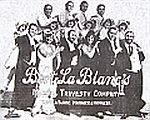
Photo courtesy of Mitchell Library from Australian Variety (1 September, 1915)
1. BERT LE BLANC'S TRAVESTY STARS PERSONNEL:
All dates shown below are established years only. In some instances, people may have been associated with the company prior to or after the dates shown, but these years have not yet been identified.
An analysis of reviews published during the course of the Travesty Stars' time together indicates that while Le Blanc and Mack were the stars, the troupe's popularity was also largely in response to the experienced support ensemble. This is a factor that was similarly significant in the success of Stiffy and Mo. Both Le Blanc and Nat Phillips have acknowledged the importance of the performers who supported them, and were keenly aware that they needed experienced and versatile performers capable of handling any type of performance situation, especially improvisation. In a 1916 interview with Australian Variety Le Blanc draws attention to this aspect of his success when he says, 'I am very fortunate in securing the services of the people whom I have. To my way of thinking no man should attempt to produce unless he is a capable actor, and [and he should be] not be afraid to do the same things he is telling his actors to do' (5 January 1916, n. pag.).
The Travesty Stars remained largely the same during this period. Of the original troupe's principal cast members only Carlton Chase and Jack Mack were not engaged by George Willoughby for his 1914 pantomime, The Babes in the Wood (Adelphi Theatre, Sydney). However, Jake Mack toured with the pantomime during the first half of 1915 (beginning in Brisbane, 22 February).
Le Blanc's company in 1921, which toured under the auspices of William Anderson, was known as The Who's Who Costume Revue Entertainers.
Although the membership of the Pony Ballet changed often over the years, these changes were almost always staggered so as to maintain a high level of continuity and consistency.
1. Key troupe members were Mary Anderson (1921), Ernest Barraclough (1922-1923), Carlton Chase (1915-1918), Lillian Colenzo (1918-1919), Mike Connors (1917-1920), Hartley Court (1922-1923), Fred Deal (1921), Charles Delavale (1922-1924), May Down (1921), Bert Dudley (1922-1923), Evelyn Dudley (1922-1923), Clym Edgares (1915-1917), Mark Erickson (1922-1923), Nellie Fallon (1915-1919), Nell Fleming (1922-1923), Fred Garland (1922-1923), Syd Garti (1918), Frank Graham (1921), Sydney Hollister (1921), Leslie Jephcott (1918), Essie Jennings (1917-1919), Glenmore Jones (1915-1917), D'Arcy Kellway (1919), Winifred Knight (1916-1922), Holly Leslie (1915-1917), Harry McDonna (1918), Jake Mack (1915-1919), Dolly MacIntosh (1922-1923), Jean Maynard (1921), Durham Marcel (1915-1918), Nora Marrs (1921), Jean Maynard (1921), Dulcie Melva (1922-1923), Maud Miles (1915-1916, 1918), Sylvie Millers (1921), Ivy Moore (1917), Clarice Norman (1921), Queenie Paul (1917-1920), Jack Quinlan (1915-1917), Bert Ray (1919), Olga Ray (1918), Will Raynor (1918-1919), Neville Royal (1919), Elvie Stagpoole [aka Mrs Charles Delavale] (1922-1924), Ted Stanley (1921), Lance Vane (1918-1919), Harry Vernon (1921), Alice Walton (1921), Molly Warren (1922-1923), Dan Weldon (1921), Fred Witt (1917-1918).
2. Short-term performers and/or guest artists included Carrie Moore (1915), Arthur Elliott (1920), Jim Gerald (1919), Wee McGregor (1918), Podzey McGuire (1918).
3. Members of the Pony Ballet chorus included Dot Bellion (1916-1917), Rose Brennan (1918-1919), Germaine Casier (1922-1923), Lily Clark (1916-1917), Lucy Cliff (1919), Tilly and Florrie Dalbro (1922-1923), Essie Davis (1919), Violet De Lacy (1916), Rosie Downie (1919), Rene Esler (1922-1923), Thelma Gourlay (1919), Annie Henry (1917-1919), Alma Hilson (1919), Marie Lannan (1916-1917), Alice Lewis (1919), Hilda Lynn (1918-1919), Kitty McGuire (1917), Dot Neville (1922-1923), Gladys Nyhoym (1916), Florrie Parkes (1922-1923), Letty Patten (1916), Violet and Rita Penson (1918-1919), Bertha Rush (1919), Vera Tandy (1918-1919), Trixie Wilson (1917).
4. Musicians and music directors included George Powell (Music Director, 1921)
5. Additional notes and/or historical clarification :
.
This entry has been sourced from research undertaken by Dr Clay Djubal into Australian-written popular music theatre (ca. 1850-1930). See also the Australian Variety Theatre Archive